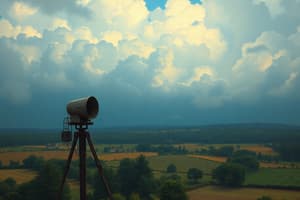Podcast
Questions and Answers
What is the typical altitude range for high-altitude aircraft used as airborne platforms for remote sensing?
What is the typical altitude range for high-altitude aircraft used as airborne platforms for remote sensing?
- 700-1500 km
- Up to 50 m
- From about 100 km to 36000 km
- Up to 50 km (correct)
Which type of orbit do low-level Earth Observation satellites (LEO) usually have?
Which type of orbit do low-level Earth Observation satellites (LEO) usually have?
- Polar orbiting satellite
- Equatorial orbiting satellites (correct)
- Oblique orbiting satellites
- Geosynchronous satellites
What is a characteristic of geosynchronous satellites?
What is a characteristic of geosynchronous satellites?
- They operate at altitudes of 700-1500 km
- They precess around the Earth at rates related to the rotation of the Earth on its polar axes (correct)
- They have equatorial orbits
- They have sunsynchronous orbits
At what altitude do low-level satellites used for Earth Observation typically operate?
At what altitude do low-level satellites used for Earth Observation typically operate?
Which type of platforms are rockets and space shuttles classified as?
Which type of platforms are rockets and space shuttles classified as?
What does it mean for a satellite to have a sunsynchronous orbit?
What does it mean for a satellite to have a sunsynchronous orbit?
What is the main motivation for remote sensing from space?
What is the main motivation for remote sensing from space?
Which of the following is an example of a natural source used in passive remote sensing?
Which of the following is an example of a natural source used in passive remote sensing?
Which method of remote sensing uses an artificial source of radiation?
Which method of remote sensing uses an artificial source of radiation?
In remote sensing, what does RADAR stand for?
In remote sensing, what does RADAR stand for?
Which field does NOT benefit from the use of satellite remote sensing?
Which field does NOT benefit from the use of satellite remote sensing?
What is the main difference between active and passive remote sensing methods?
What is the main difference between active and passive remote sensing methods?
What does radiometric resolution measure?
What does radiometric resolution measure?
Which resolution measures how often an area can be revisited?
Which resolution measures how often an area can be revisited?
What is the temporal resolution for some systems?
What is the temporal resolution for some systems?
Which system has a 1-bit radiometric resolution?
Which system has a 1-bit radiometric resolution?
What can be measured using radar and satellite meteorology?
What can be measured using radar and satellite meteorology?
Which parameter is NOT typically measured by radar and satellite meteorology?
Which parameter is NOT typically measured by radar and satellite meteorology?
What is the purpose of the Cloud-Aerosol Transport System (CATS)?
What is the purpose of the Cloud-Aerosol Transport System (CATS)?
What is the altitude at which Korea's geostationary meteorological satellite series orbits?
What is the altitude at which Korea's geostationary meteorological satellite series orbits?
Which satellite mission demonstrates and extends access to AIS signals beyond the land-based system?
Which satellite mission demonstrates and extends access to AIS signals beyond the land-based system?
For how many years was the Aqua satellite mission intended to operate?
For how many years was the Aqua satellite mission intended to operate?
Which instrument is NOT part of the Cloud-Aerosol Transport System (CATS)?
Which instrument is NOT part of the Cloud-Aerosol Transport System (CATS)?
What does CATS aim to provide measurements of?
What does CATS aim to provide measurements of?
What remains constant as electromagnetic energy is propagated through media of different densities?
What remains constant as electromagnetic energy is propagated through media of different densities?
Which property of short-wavelength radiation must be high due to all types of electromagnetic radiation traveling at the speed of light?
Which property of short-wavelength radiation must be high due to all types of electromagnetic radiation traveling at the speed of light?
What is wavenumber defined as?
What is wavenumber defined as?
What does the electromagnetic spectrum distribute according to energy, wavelength, or frequency?
What does the electromagnetic spectrum distribute according to energy, wavelength, or frequency?
Which property of electromagnetic radiation changes as it is propagated through media of different densities?
Which property of electromagnetic radiation changes as it is propagated through media of different densities?
Flashcards are hidden until you start studying
Study Notes
High-Altitude Aircraft and Remote Sensing
- High-altitude aircraft used for remote sensing typically operate at altitudes ranging from 15,000 to 45,000 feet.
Low-Level Earth Observation Satellites
- Low-level Earth Observation satellites (LEO) generally have a Low Earth Orbit, usually between 160 to 2,000 kilometers above the Earth.
Geosynchronous Satellites
- Geosynchronous satellites maintain a fixed position relative to the Earth, orbiting at an altitude of approximately 35,786 kilometers.
Altitude of Low-Level Satellites
- Low-level satellites for Earth Observation typically operate at altitudes ranging from 160 to 2,000 kilometers.
Rocket and Space Shuttle Classification
- Rockets and space shuttles are classified as launch platforms or space transportation systems.
Sunsynchronous Orbit
- A sunsynchronous orbit allows a satellite to pass over the same part of the Earth at the same local solar time, maintaining a consistent position relative to the Sun throughout the year.
Motivation for Remote Sensing
- The main motivation for remote sensing from space is to gather data for environmental monitoring, disaster management, and resource management.
Passive Remote Sensing Natural Sources
- An example of a natural source used in passive remote sensing is sunlight, which is utilized to capture reflected light from the Earth's surface.
Active Remote Sensing Method
- Active remote sensing involves the use of an artificial source of radiation, such as lasers or radar systems.
RADAR in Remote Sensing
- RADAR stands for Radio Detection and Ranging, a technique used to detect the distance and speed of objects.
Satellite Remote Sensing Limitations
- Agriculture, remote sensing typically benefits from satellite technology, whereas fields like urban planning do not primarily rely on satellite remote sensing.
Active vs Passive Remote Sensing
- The main difference is that active remote sensing systems emit their own energy to illuminate the target, while passive systems rely on natural energy sources.
Radiometric Resolution Measurement
- Radiometric resolution measures the sensitivity of a sensor to differences in intensity of electromagnetic radiation.
Temporal Resolution in Remote Sensing
- Temporal resolution refers to how often a satellite can revisit the same area, indicating the frequency of data capture.
1-Bit Radiometric Resolution System
- A 1-bit radiometric resolution system captures data in binary format, limiting detail to on/off states.
Measurement Capabilities of Radar and Satellite Meteorology
- Radar and satellite meteorology can be used to measure precipitation, cloud cover, and atmospheric conditions.
Parameters Excluded from Radar Measurements
- Radar and satellite meteorology do not typically measure geological features directly.
Cloud-Aerosol Transport System (CATS) Purpose
- CATS aims to provide measurements of the transport and distribution of clouds and aerosols in the atmosphere.
Geostationary Meteorological Satellite Altitude
- Korea's geostationary meteorological satellite series orbits at an altitude of around 35,786 kilometers.
AIS Signals Extension Mission
- The satellite mission that extends access to Automatic Identification System (AIS) signals beyond land-based systems is the European Space Agency's Sentinel-1.
Aqua Satellite Mission Duration
- The Aqua satellite mission was intended to operate for a duration of five years.
Instruments Not in CATS
- An example of an instrument not part of the Cloud-Aerosol Transport System is a lidar.
CATS Measurement Goals
- CATS aims to provide precise measurements of aerosol heights, locations, and types as well as cloud properties.
Electromagnetic Energy Propagation Consistency
- The frequency of electromagnetic energy remains constant as it propagates through media of different densities.
Property of Short-Wavelength Radiation
- Short-wavelength radiation requires a high energy level to maintain its properties due to the speed of all types of electromagnetic radiation traveling at the speed of light.
Wavenumber Definition
- Wavenumber is defined as the number of waves per unit distance, often expressed in inverse centimeters.
Electromagnetic Spectrum Characteristics
- The electromagnetic spectrum distributes energy, wavelength, or frequency in a continuum that spans from gamma rays to radio waves.
Property Changes in Electromagnetic Radiation
- The speed and wavelength of electromagnetic radiation change as it is propagated through media of different densities.
Studying That Suits You
Use AI to generate personalized quizzes and flashcards to suit your learning preferences.




